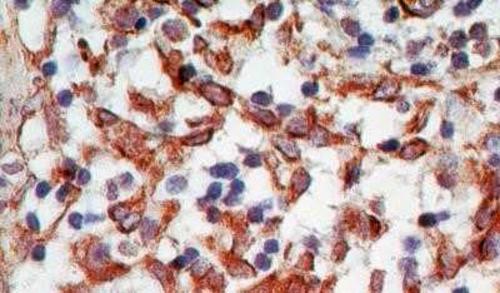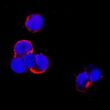RANKL (TNFSF11) Mouse Monoclonal Antibody [Clone ID: 12A668]
Frequently bought together (2)
Transient overexpression lysate of tumor necrosis factor (ligand) superfamily, member 11 (TNFSF11), transcript variant 1
USD 436.00
Other products for "TNFSF11"
Specifications
| Product Data | |
| Clone Name | 12A668 |
| Applications | IHC, WB |
| Recommended Dilution | ELISA, Chromatin Immunoprecipitation (ChIP): 1:10-1:500, Flow (Cell Surface), Immunoassay, Immunohistochemistry: 1:10-1:500, Immunohistochemistry-Paraffin: 5 ug/ml, Immunocytochemistry/ Immunofluorescence: 20 ug/ml, Western Blot: 0.5-2 ug/ml |
| Reactivities | Human, Mouse, Rat |
| Host | Mouse |
| Isotype | IgG1, kappa |
| Clonality | Monoclonal |
| Immunogen | A bacterially expressed fusion protein containing amino acid residues 1-317 of mouse TRANCE was used as immunogen (NP_003692). |
| Formulation | PBS containing 0.05% BSA, 0.05% Sodium Azide. Store at 4C short term. Aliquot and store at -20C long term. Avoid freeze-thaw cycles. |
| Concentration | lot specific |
| Purification | Protein G purified |
| Conjugation | Unconjugated |
| Storage | Store at -20°C as received. |
| Stability | Stable for 12 months from date of receipt. |
| Predicted Protein Size | 35 kDa |
| Gene Name | tumor necrosis factor superfamily member 11 |
| Database Link | |
| Background | TRANCE/OPGL/RANKL/ODF is a recently identified member of tumor necrosis factor family. TRANCE (TNF-related activation-induced cytokine receptor) or RANKL {receptor activator of NF-kB (RANK) ligand} has been implicated in interactions between T cells and dendritic cells. RANK ligand (RANKL/TRANCE) binds to RANK on dendritic cells, upregulates the expression of anti-apoptotic protein BcL-XL suggesting a role in dendritic cell survival. TRANCE/RANKL is also important in T and B-cell maturation. As OPGL/ODF (Osteoprotegerin Ligand/Osteoclast differentiation factor), the same protein can both activate mature osteoclasts and mediate osteoclastogenesis. OPGL/TRANCE deficient mice show severe osteoporesis and complete absence of osteoclasts as a result of lack of osteogenesis. |
| Synonyms | CD254; hRANKL2; ODF; OPGL; OPTB2; RANKL; sOdf; TRANCE |
| Note | Staining of formalin-fixed tissues is enhanced by boiling tissue sections in 10 mM sodium citrate buffer, pH 6.0 for 10-20 min followed by cooling at RT for 20 min. |
| Reference Data | |
| Protein Families | Druggable Genome, Transmembrane |
| Protein Pathways | Cytokine-cytokine receptor interaction |
Documents
| Product Manuals |
| FAQs |
| SDS |
{0} Product Review(s)
0 Product Review(s)
Submit review
Be the first one to submit a review
Product Citations
*Delivery time may vary from web posted schedule. Occasional delays may occur due to unforeseen
complexities in the preparation of your product. International customers may expect an additional 1-2 weeks
in shipping.






























































































































































































































































 Germany
Germany
 Japan
Japan
 United Kingdom
United Kingdom
 China
China








